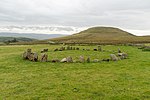St Anne's Church, Thwaites
Church of England church buildings in CumbriaChurches completed in 1854Diocese of CarlisleE. G. Paley buildingsEngvarB from September 2013 ... and 3 more
Gothic Revival architecture in CumbriaGothic Revival church buildings in EnglandGrade II listed churches in Cumbria

St Anne's Church is in the village of Thwaites, Cumbria, England. It is an active Anglican parish church in the deanery of Millom, the archdeaconry of Furness, and the diocese of Carlisle. Its benefice is united with those of St George, Millom, Holy Trinity, Millom, and St Luke, Haverigg. The church is recorded in the National Heritage List for England as a designated Grade II listed building.
Excerpt from the Wikipedia article St Anne's Church, Thwaites (License: CC BY-SA 3.0, Authors, Images).St Anne's Church, Thwaites
Chapel Brow,
Geographical coordinates (GPS) Address External links Nearby Places Show on map
Geographical coordinates (GPS)
| Latitude | Longitude |
|---|---|
| N 54.2587 ° | E -3.2633 ° |
Address
St. Anne's Church
Chapel Brow
LA18 5HP , Millom Without
England, United Kingdom
Open on Google Maps









